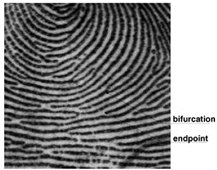Fingerprint Identification. Fingerprint Features
History of Fingerprints. Biometrics such as fingerprint, palm, face, gait, ear, signature, and speech are used to ensure a high confidence in the recognition of an individual for high-security applications (1). Among these biometric traits, fingerprints have been used for a long period of time because of their distinctiveness and immutability. The study of fingerprint characteristics can be traced back to about 4500 years, the era of the pyramid-building in Egypt. However, the use of fingerprints for identification began in the mid-1800s.
Sir William Herschel discovered that fingerprints remain stable over time and distinct across individuals. In 1877, he commenced placing the inked palm and thumb impressions of some members of the local population on contracts. These prints were used as a form of signature on the documents. However, Herschel never claimed that he had developed a method to identify criminals.
In the late 1800s, the most advanced findings in fingerprint study was made by Dr. Henry Faulds. He found that fingerprints will not change even with superficial injury and that the latent prints left on objects can be used to identify criminals. In 1892, Sir Francis Galton published an accurate and in-depth study of fingerprint science in a book called Finger Prints, in which he described an attempt at a fingerprint classification system to facilitate the handling of large collections of fingerprints.
Although the work of Galton proved to be sound and became the foundation of modern fingerprint science, his approach to classification was inadequate. Juan Vucetich, an Argentinian police officer who corresponded with Galton, devised his own fingerprint classification system, which was put into practice in September 1891. In 1897, Sir Edward Henry established the famous Henry System (2), which is a systematic and effective method of classifying fingerprints. He published the book Classification and Uses of Fingerprints in 1900. About 10 years later, his classification system was being used widely by police forces and prison authorities in the English-speaking world.
Since the early 1960s, researchers have begun to develop an automatic fingerprint identification system (AFIS) to improve the efficiency of fingerprint recognition. Today, almost all law enforcement agencies around the world use an AFIS. And fingerprint science is a well-researched field with research and development activities worldwide. Several publicly available databases (3,4) exist for evaluating the performance of various fingerprint recognition algorithms. New high-resolution electronic sensors, which are quite affordable (5,6), are available for use in portable laptop computers, mobile phones, and personal digital assistants (PDAs).
Fingerprint Features. Fingerprints have two fundamentally important characteristics: permanence and distinctiveness. It has been found that fingerprints are formed in the fetal stage and do not change naturally. Also, no two fingerprints ever are found to be exactly the same. Because of these interesting characteristics, fingerprints are used widely for human recognition and identification.
Fingerprints are represented by features that are classified at three levels.
- Level 1 features describe the patterns of the fingerprints, which include ridge flow, core and delta, and pattern type. Ridge flow is the orientation image of the fingerprint. This feature is commonly used for classification. Figure 1 shows an example of the original image and the orientation image. Core and delta are singular points that are defined as the points where the orientation field of a fingerprint is discontinuous. Core is the topmost point on the innermost recurving ridge, and delta is the center of a triangular region where flows from three different directions meet.

Figure 1. An example of the original image and the orientation image: (a) original image, (b) orientation image. The orientation is shown by the arrows above the ridges
Figure 2 is an example of the core and delta in a fingerprint. Fingerprints are generally classified into five classes: right loop (R), left loop (L), whorl (W), arch (A), and tented arch (T). Figure 3 shows examples of the fingerprints from these five classes.

Figure 2. Level 1 features: core and delta

Figure 3. Examples of fingerprints for each class based on the Henry System: (a) right loop, (b) left loop, (c) whorl, (d) arch, and (e) tented
- Level 2 features are the points of the fingerprints. They include minutiae, scar, crease, and dot (7). A fingerprint consists of white and dark curves. The white curves are called the valley and the dark curves are called the ridge. Minutiae features are the ridge characteristics that correspond to the crossings and endings of ridges. They include endpoint, bifurcation, forks, island, and enclosures. The endpoint and bifurcation are used commonly in fingerprint recognition.
Figure 4 is an example of the endpoint and bifurcation. Scar is the crossing of two or more adjacent ridges. Figure 5 (a) shows an example of a scar. A crease appears as a white line in a fingerprint. It is a linear depression (or grooves) in the skin. Figure 5 (b) shows an example of a crease. A dot is an isolated ridge unit with a pore on it. Figure 5 (c) shows an example of a dot.

Figure 4. Minutiae: endpoint and bifurcation

Figure 5. Level 2 features: (a) scar, (b) crease, and (c) dot
- Level 3 features (5) describe the fingerprint shape that refers to pores and ridge contours. Pores are small openings on ridges. We need a high resolution sensor (>1000 pixels per inch (ppi)) to get this feature. Figure 6 is an example of sweat pores. Ridge contours are morphological features that include ridge width, shape, path deviation, and so forth.
Fingerprint sensors, the very front end of the fingerprint recognition systems, are used to capture the fingerprint images. The kinds of fingerprint sensors are: optical sensors, semiconductor sensors, and ultrasound sensors. Among these sensors, optical sensors are considered to be stable and reliable, semiconductor sensors are considered to be low cost and portable, and ultrasound sensors are considered to be accurate but more expensive.
Date added: 2024-02-27; views: 494;
